Yoga poses are actually taken for the betterment of your mental and physical well being. The various yoga poses are immensely beneficial for an individual’s health. However, some yoga poses can be very hard on the body of an individual. Individuals with knee pain should take into account certain poses which may harm their knees. There are many poses which require the knees to be flexible and some other poses require the knees to be able to carry the total body weight. People with knee injury should avoid such poses as this can lead to complications. Therefore, it is very essential that one knows which poses an individual with knee joint pain should avoid. This will help him/her to strengthen his/her knees and will not cause much distress. Read through to know what all you should avoid if you suffer from knee pain:
1. Lotus pose
 Lotus pose should be avoided by those individuals who have knee joint pain. For this pose, you need to be able to stretch out your knees easily or else you can cause injury to your knees. Doing the pose suddenly without any prior preparation can also cause injury. For this pose, an individual should sit cross-legged on the floor. Both the feet of the individual should be tucked over the inner thighs. This is a pose where knee injury can take place. Since this is an advanced pose of yoga, it should not be tried unless one is sure of his/her capability.
Lotus pose should be avoided by those individuals who have knee joint pain. For this pose, you need to be able to stretch out your knees easily or else you can cause injury to your knees. Doing the pose suddenly without any prior preparation can also cause injury. For this pose, an individual should sit cross-legged on the floor. Both the feet of the individual should be tucked over the inner thighs. This is a pose where knee injury can take place. Since this is an advanced pose of yoga, it should not be tried unless one is sure of his/her capability.
2. Hero pose
Hero pose should be avoided by individuals with bad knees. This pose is done by sitting on your heels with the bottom of your legs tucked under it. This pose provides a deep stretch for the top portions of your legs and feet. An advanced pose will be to recline the upper part of your body behind so that your elbows touch the ground. In the advanced pose, the whole back of the individual will be on the ground. People with knee injury may not be able to open their body and this will be harmful for their health.
3. Triangle pose
 In this pose, the joints are flexed too far and this may harm your knees. The unhealthy tension that arises in the pose due to the over stretching may cause knee problems. This occurs when an individual tries to stretch his legs after the triangle pose. For doing the triangle pose, the person should lock his knees and hang out in their joints instead of taking the help of the leg muscles for support. Pressing too hardly on the joint can lead to over-exerting the knee muscles which further can cause serious damage to the knees.
In this pose, the joints are flexed too far and this may harm your knees. The unhealthy tension that arises in the pose due to the over stretching may cause knee problems. This occurs when an individual tries to stretch his legs after the triangle pose. For doing the triangle pose, the person should lock his knees and hang out in their joints instead of taking the help of the leg muscles for support. Pressing too hardly on the joint can lead to over-exerting the knee muscles which further can cause serious damage to the knees.
4. Warrior pose
In this pose the back toes face at a forty five degree angle. The knees also are turned in the same direction. In this position, if an individual turns his hips further, the knee joint will bear the twist. This twist can be very beneficial for individuals with no knee joint pains or similar knee problems. But with individuals who have problems in their knees, trying this pose can harm their knees seriously and even can break them.
5. Side angle pose
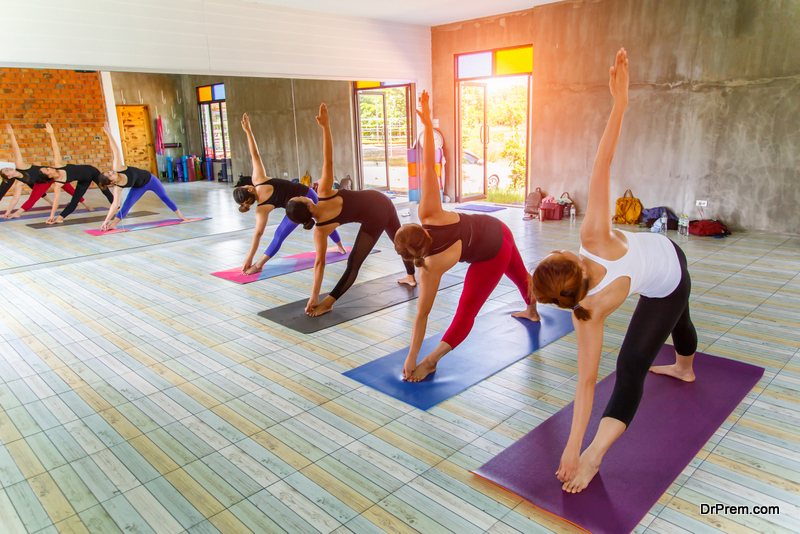 For doing this pose, the feet of the individual must be kept apart for with a gap of about five feet. Then the left foot must be turned ninety degrees and the right foot about ten degrees. When an individual has found balance doing this posture, the left heel is turned into the floor and the left knee is bend, keeping the thighs parallel to the ground. The torso should be tilted to the left. The left elbow should be brought to the left thigh. The right arm should be stretched over the head and the palm should be faced down. The whole left side of the torso should be brought forward and the right side back. This position due to the intricate knee and thigh movement can be very excruciating for those individuals with knee pain. It is better for them to avoid such a pose.
For doing this pose, the feet of the individual must be kept apart for with a gap of about five feet. Then the left foot must be turned ninety degrees and the right foot about ten degrees. When an individual has found balance doing this posture, the left heel is turned into the floor and the left knee is bend, keeping the thighs parallel to the ground. The torso should be tilted to the left. The left elbow should be brought to the left thigh. The right arm should be stretched over the head and the palm should be faced down. The whole left side of the torso should be brought forward and the right side back. This position due to the intricate knee and thigh movement can be very excruciating for those individuals with knee pain. It is better for them to avoid such a pose.
6. Pigeon pose
Individuals when doing this pose are asked to rotate their legs externally. They may even be asked to turn out their front leg. This posture puts a good amount of pressure on the knees while practicing the pigeon pose. Individuals with tight inner, outer and front thighs should avoid this pose so as not to cause much harm to their knees.
7. Chair pose
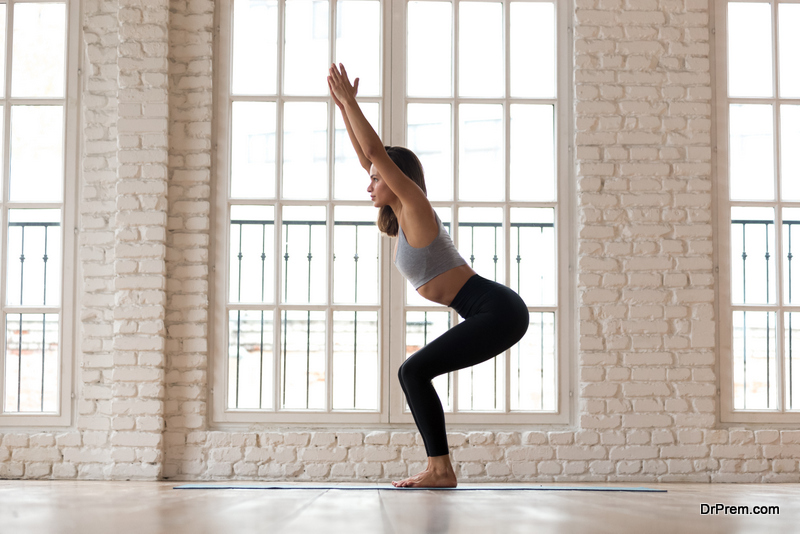 The chair pose, also referred to as Utkatasana has been found to be very healthy in individuals for building strength in the important knee muscles. The bending of the knees that the posture demands however may cause much strain on the knees of the individual. This toning procedure may be good for the muscles but it may harm the knee joint and may increase the pain.
The chair pose, also referred to as Utkatasana has been found to be very healthy in individuals for building strength in the important knee muscles. The bending of the knees that the posture demands however may cause much strain on the knees of the individual. This toning procedure may be good for the muscles but it may harm the knee joint and may increase the pain.
8. Supported pigeon posture
In this pose, the upper body weight is on the knee which is in a bending position. The individual in the course of the exercise schedule have to move the front leg further and this will lead to putting more pressure on the knees. People with knee injury or sensitive knees should avoid this pose as this may lead to complications in the knees.
9. Tree pose
 The tree pose is taken mainly by individuals to improve the balance in their bodies. This also strengthens the legs of the individuals. For doing this pose, the individual must stand on a mat straight with hands by their sides. Next, the right knee will be opened up to the side and lifted off the mat. Shift the weight to the other leg and inhale deeply. The foot should next be raised up to the calf and the hands should be brought overhead and the palms should be together. Breathing deeply and then relaxing is the whole complete pose. However, this pose may harm your knees as the whole body weight will be on your one knee. And moreover the stretching and bending may cause problems for people with knee problems.
The tree pose is taken mainly by individuals to improve the balance in their bodies. This also strengthens the legs of the individuals. For doing this pose, the individual must stand on a mat straight with hands by their sides. Next, the right knee will be opened up to the side and lifted off the mat. Shift the weight to the other leg and inhale deeply. The foot should next be raised up to the calf and the hands should be brought overhead and the palms should be together. Breathing deeply and then relaxing is the whole complete pose. However, this pose may harm your knees as the whole body weight will be on your one knee. And moreover the stretching and bending may cause problems for people with knee problems.
Exercises to avoid with knee pain
Knee pain is a real hindrance to exercise. If you continue to exercise, you may even make it worse. Low impact exercises such as walking or bicycling might help to keep the knee supple and flexible. You may feel that you are not reaching your fitness goals with these exercises, and might start doing some strenuous exercises. Here are some of the exercises to avoid when you have knee pain or else it may exacerbate your pain:
10 Exercises to avoid with knee pain
1. Jumping
 When you have knee pain, you should never attempt to do any exercise which involves jumping. Jumping is very high impact, which will shock the knee joint and stress it when you land. The exercises which involve jumping are called ‘plyometrics’, for example basketball, where you have to jump repeatedly. It’s one of the exercises to avoid if you suffer from knee pain, as you will place upto three times your body weight on your knee, and might potentially increase the chances of pain and injury.
When you have knee pain, you should never attempt to do any exercise which involves jumping. Jumping is very high impact, which will shock the knee joint and stress it when you land. The exercises which involve jumping are called ‘plyometrics’, for example basketball, where you have to jump repeatedly. It’s one of the exercises to avoid if you suffer from knee pain, as you will place upto three times your body weight on your knee, and might potentially increase the chances of pain and injury.
The best alternative to jumping could be cycling and swimming.
2. Squats
Squats involve excessive flexing of the knees, which are certainly not good for bad knees. Physical therapistsdo not recommend squats as deep squats requires extreme bending of the knee joint, and the knees have to support the entire body weight. Squats, therefore, too are some of the exercises to avoid when you have knee pain. Apart from the quads, glutes, hamstrings too would not be able to sustain as the knee is weak.
Do a version of the squat, which will not hurt so much, or damage your knee. Some Bulgarian split squats will give you the satisfaction of doing squats (with weights). But do inform your trainer, so that he/she will be able to guide you the best way.
3. Running
 Running is quite in vogue today and you must be seeing many runners in the park and on the pavement. If you like to stay fit, you must be thinking of running is one of the best exercises for you. It’s saddening, but if you’re plagued by bad knees, running is an activity you definitely should avoid. It’s quite high impact, and your knees will be under a lot of strain. Running on concrete or the pavement is not advisable at all, and will make your knees’ pain worse. Running is therefore one of the exercises to avoid when you have knee joint problems.
Running is quite in vogue today and you must be seeing many runners in the park and on the pavement. If you like to stay fit, you must be thinking of running is one of the best exercises for you. It’s saddening, but if you’re plagued by bad knees, running is an activity you definitely should avoid. It’s quite high impact, and your knees will be under a lot of strain. Running on concrete or the pavement is not advisable at all, and will make your knees’ pain worse. Running is therefore one of the exercises to avoid when you have knee joint problems.
If you still want to run, then you can do a gentle run on dirt tracks and level surfaces. Never run downhill, but run uphill instead. And please do buy the right running shoes so that your knees get the protection and support they need.
4. Any sport activity which requires change of direction
Any sports which need you to change direction frequently and suddenly should be avoided. Games like volleyball, soccer, skiing and basketball are a strict no-no as your knees will feel the stress. Let the knee problem improve before playing any of these sports.
5. Kickboxing
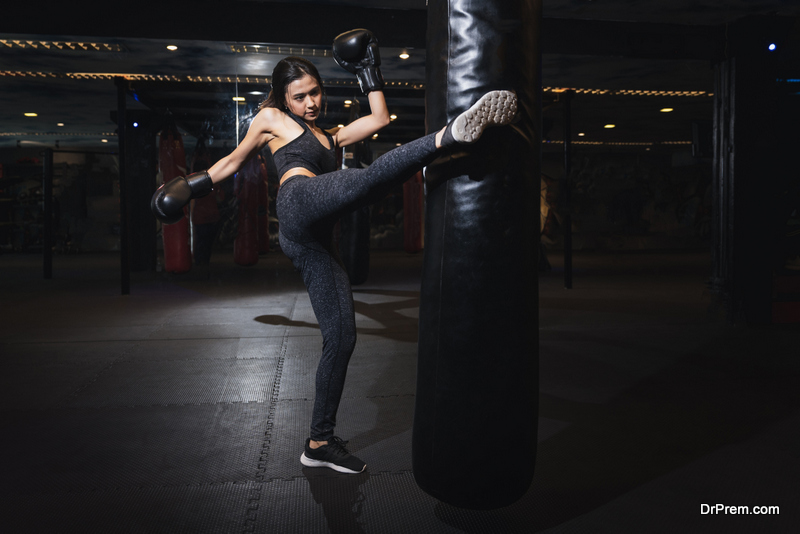 Kickboxing is a great activity but it entails a lot of kicking. According to the Health and Fitness Association, many people suffer from knee injuries while kickboxing. If you have prior knee joint problems, then the actions like side, front and back kicks, knee lifts and roundhouse kicks can give a big jolt to the knees and exacerbate pain.
Kickboxing is a great activity but it entails a lot of kicking. According to the Health and Fitness Association, many people suffer from knee injuries while kickboxing. If you have prior knee joint problems, then the actions like side, front and back kicks, knee lifts and roundhouse kicks can give a big jolt to the knees and exacerbate pain.
6. Full depth lunge
In this type of lunges, your knee has to touch the ground. You might feel excruciating pain and place a lot of stress on the knee joints. Your fluid sac which is on top of the patella, or knee cap can be irritated, when your knee hits the ground. You might even fracture the knees, and there might be swelling, bruising and dislocation. So full depth lunges are the exercises to avoid when you have bad knees.
The best alternative is to don’t do a full lunge, and prevent the rear knee from lowering. Do a shallow lunge to the point where it is comfortable for your knees.
7. W sit stretch
 In this exercise, you have to sit with the knees bent and splayed out in a stance which resembles the W letter. This is the exercise preferred by some athletes to stretch the quadriceps and hips. But you have to avoid it even if you have a little problem with your knees, as it involves a huge amount of torque to the ankle, hip and knees.
In this exercise, you have to sit with the knees bent and splayed out in a stance which resembles the W letter. This is the exercise preferred by some athletes to stretch the quadriceps and hips. But you have to avoid it even if you have a little problem with your knees, as it involves a huge amount of torque to the ankle, hip and knees.
The alternative to the W stretch is that you can try some hip rotations with the knees bent at right angle. The stretch rotates the pelvis and trunk and limits the flexion as well as stress of the knee.
8. Duck Walks
Duck Walks are also one of the exercises to avoid when you are having knee problems. It stresses out the knees’ ligaments as well as cartilage. Experts say that this exercise does not help much in strengthening the body or losing weight, so you can stay clear of this exercise.
9. Hurdle Stretch
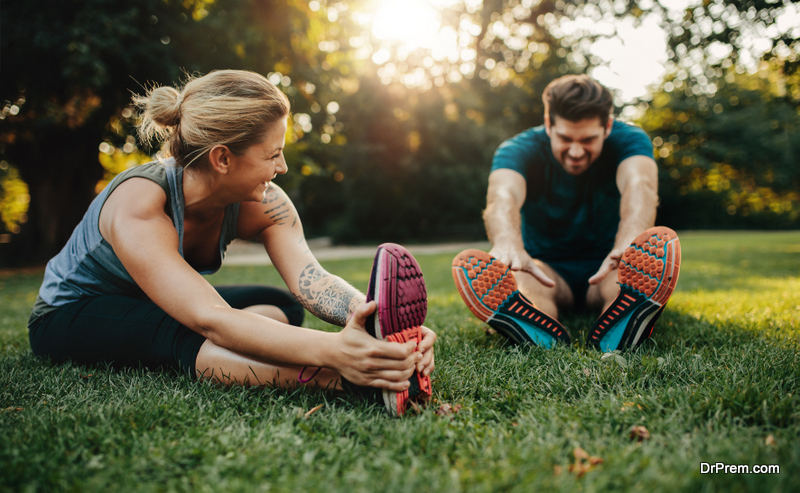 Another exercise with weights which is never to be attempted by you, is the Hurdle Stretch. It involves rotating your knee when you twist, which puts a stress on the medial knee joint and the meniscus.
Another exercise with weights which is never to be attempted by you, is the Hurdle Stretch. It involves rotating your knee when you twist, which puts a stress on the medial knee joint and the meniscus.
10. Leg press machine
While exercising on this machine, you have to be supervised by your trainer, who will advise the correct number of weights you should use. Otherwise, you might be tempted to use weights which are too heavy for you, and cause more injury to your knees.
How to walk and run upstairs safely
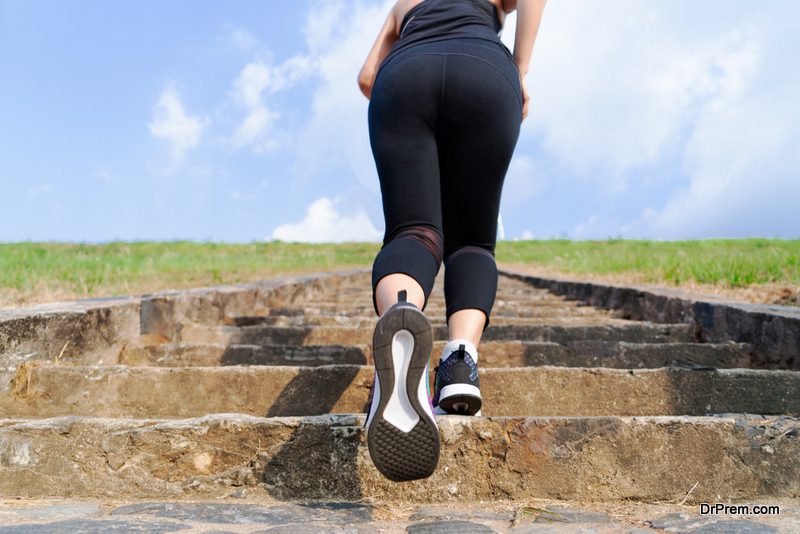 There is a long list of exercises which are a no-no for you. But you do have to walk and run, and maybe use these activities as the best exercises for you. Walking upstairs and downstairs can strengthen your hip and leg muscles, increase knee joint fluid production, lubricate the knee joints and wash away any toxins.
There is a long list of exercises which are a no-no for you. But you do have to walk and run, and maybe use these activities as the best exercises for you. Walking upstairs and downstairs can strengthen your hip and leg muscles, increase knee joint fluid production, lubricate the knee joints and wash away any toxins.
To climb up safely, climb slowly, holding on to the railing for extra support without overextending the knees. Or you can use a stair stepper machine – start with shorter workouts, increasing duration in time. Adjust the rise height according to your knees, and do not lean on the rails.
Water aerobics, swimming and walking slowly can help to strengthen your knees. Whatever exercises you do, be sure to do them with the advice of your trainer or physiotherapist.


